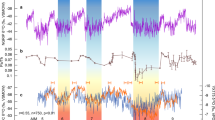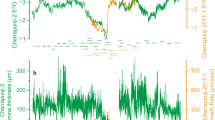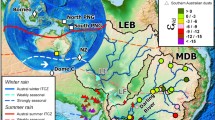Abstract
There is evidence that climate pulsations during the Wisconsin-Holocene transition were accompanied by strong fluctuations in the intensity of North Atlantic Deep Water production. It appears likely that these fluctuations were largely a result of pulsed meltwater input. The production of NADW is intimately tied to global heat budget asymmetries (North vs. South, Atlantic vs. Pacific) and of course to the regional heat budget of the North Atlantic, which in turn acts as a climate amplifier system. Both albedo feedback and carbon dioxide feedback mechanisms would seem to depend on (and influence) NADW production. The type of arguments used to reconstruct NADW production are illustrated using isotopie, micropaleontologic and sedimentologie data from a box core in the central South Atlantic.
Access this chapter
Tax calculation will be finalised at checkout
Purchases are for personal use only
Preview
Unable to display preview. Download preview PDF.
Similar content being viewed by others
References
Andree, M., Oeschger, H., Broecker, W.S., Beavan, N., Klas, M., Mix, A., Bonani, G., Hofmann, H.J., Suter, M., Woelfli, W. and Peng, T.H., 1986. Limits on the ventilation rate for the deep ocean over the last 12000 years, Climate Dynamics, 1: 53–62.
Baumgartner, A. and Reichel, E., 1975. The World Water Balance Elsevier, Amsterdam, 179pp., maps.
Berger, W.H., 1970. Biogenous deep-sea sediments: fractionation by deep-sea circulation, Bull. Geol. Soc. Am., 81: 1385–1402.
Berger, W.H., 1977. Carbon dioxide excursions and the deep-sea record: aspects of the problem. In: N.R. Andersen and A. Malahoff (eds) The Fate of Fossil Fuel C0 2 in the Oceans, Plenum New York, p. 505–542.
Berger, W.H., 1978. Oxygen-18 stratigraphy in deep-sea sediments: additional evidence for the deglacial meltwater effect, Deep-Sea Res., 25: 473–480.
Berger, W.H., 1982a. Climatesteps in ocean history - lessons from the Pleistocene. In: W.H. Berger and J.C. Crowell (eds) Climate in Earth History, Studies in Geophysics, National Academy Press, Washington D.C., p. 43–54.
Berger, W.H., 1982b. On the definition of the Pleistocene-Holocene boundary in deep-sea sediments, Sveriges geologiska unders&kning, Avhand Uppsat., 76 (7), Ser. C (794): 270–280
Berger, W.H., 1985. Carbon dioxide increase and climate prediction: clues from deep-sea carbonates, Episodes, 8: 163–168.
Berger, W.H., in press. Ocean ventilation during the last 12,000 years: hypothesis of counterpoint deep water production, Marine Geology.
Berger, W.H. and Gardner, J.V., 1975. On the determination of Pleistocene temperatures from planktonic foraminifera, J. Foram. Res., 5 (2): 102–113.
Berger, W.H. and Killingley, J.S., 1982a. The Worthington Effect and the origin of the Younger Dryas, J. Mar. Res. (Supplement), 40: 27–38.
Berger, W.H. and Vincent, E., 1986a. Deep-sea carbonates: reading the carbon isotope signal, Geol. Rundschau, 75 (1): 249–269.
Berger, W.H. and Vincent, E., 1986b. Sporadic shutdown of North Atlantic deep water production during the Glacial-Holocene transition?, Nature, 324: 53–55.
Berger, W.H., Killingley, J.S., Metzler, C.V. and Vincent, E., 1985a. Two-step déglaciation: 14C-dated high resolution 5180 records from the tropical Atlantic Ocean, Quat. Res., 23: 258–271.
Berger, W.H., Killingley, J.S. and Vincent, E., 1985b. Timing of déglaciation from an oxygen isotope curve for Atlantic deep-sea sediments, Nature, 314: 156–158.
Berger, W.H., Killingley, J.S. and Vincent, E., 1987. Timescale of Wisconsin/Holocene transition: oxygen isotope record in the Western Equatorial Pacific. Quaternary Research, in press.
Boyle, E.A. and Keigwin, L.D., 1982. Deep circulation of the North Atlantic over the last 200,000 years: geochemical evidence, Science, 218: 784–787.
Boyle, E.A. and Keigwin, L.D., 1985. Comparison of Atlantic and Pacific paleochemical records for the last 215,000 years: changes in deep ocean circulation and chemical inventories, Earth and Planet. Sci. Lett., 76: 135–150.
Broecker, W.S. and Van Donk, J., 1970. Isolation changes, ice volumes, and the 018 record in deep-sea cores, Reviews of Geophysics and Space Physics, 8: 169–198.
Broecker, W.S., Peteet, D.M. and Rind, D., 1985. Does the ocean-atmosphere system have more than one stable mode of operation?, Nature, 315: 21–26.
Caralp, M., 1970. Essai de stratigraphie du Pleistocène marin terminal d’ après les paléoclimats observés dans des carottes du Golfe de Gascogne, Bull. Soc. Géol. Fr., 712: 403–412.
CLIMAP Project Members, 1976. The surface of the ice-age Earth, Science, 191: 1131–1137.
Corliss, B.H., 1982. Linkage of North Atlantic and Southern Ocean deep-water circulation during glacial intervals. Nature, 298: 458–460.
Curry, W.B. and Lohmann, G.P., 1982. Carbon isotopie changes in benthic foraminifera from the Western South Atlantic: reconstruction of glacial abyssal circulation patterns, Quat. Res., 18: 218–235.
Curry, W.B. and Lohmann, G.P., 1983. Reduced advection into Atlantic Ocean deep eatern basins during last glaciation maximum, Nature, 306: 577–580.
Dansgaard, W., Johnsen, S.J., Clausen, H.B., Dahl-Jensen, D., Gundestrup, N., Hammer, C.V. and Oeschger, H., 1984. North Atlantic climatic oscillations revealed by deep Greenland ice cores. In: J.E. Hansen and T. Takahashi (editors), Climate Processes and Climate Sensitivity, Geophys Monogr. 29, Am. Geophys. Union, Washington, D.C., pp. 288–298
Dansgaard, W.,1987. Ice core evidence of abrupt climatic change, this volume
Duplessy, J.-C., Chenouard, L. and Vila, F., 1975. Weyl’s theory of glaciation supported by isotopie study of Norwegian Core K 11, Science, 188: 1208–1209.
Duplessy, J.-C., Moyes, J. and Pujol, C., 1980. Deep water formation in the North Atlantic Ocean during the last ice age, Nature, 286 (5772): 479–482.
Duplessy, J.-C., Delbrias, G., Turon, J.L., Pujol, C. and Duprat, J., 1981a. Deglacial warming of the northeastern Atlantic Ocean: correlation with the paleoclimatic evolution of the European continent, Palaeogeo., Palaeoclim., Palaeoeco., 35 (2–4): 121–144.
Duplessy, J.-C., Bé, A.W.H. and Blanc, P.L., 1981b. Oxygen and carbon isotopic composition and biogeographic distribution of planktonic foraminifera in the Indian Ocean, Palaeogeo., Palaeoclim., Palaeoeco., 33 (1–3): 9–16.
Emiliani, C., 1955. Pleistocene temperatures, J. Geol., 63: 538–578.
Foster, T.D. and Carmack, E.C., 1976. Frontal zone mixing and Antarctic Bottom Water formation in the Southern Weddell Sea. Deep-Sea Res. 23: 301–317.
Gordon, A., 1985. Indian-Atlantic transfer of thermocline water at the Agulhas retrofleetion, Science, 221: 1030–1033.
Hammer, C.U., Clausen, H.B., Dansgaard, W., Neftel, A., Kristinsdottir, P. and Johnson, E., 1985. Continuous impurity analysis along the Dye 3 deep core. In: Langway, C.C., Oeschger, H., Dansgaard, W. (eds) Greenland Ice Core: Geophysics, Geochemistry, and the Environment, Geophysical Monograph 33: 90–94 American Geophysical Union, Washington, D.C.
Imbrie, J., Abrupt terminations of Late Pleistocene ice ages: a simple Milankovitch explanation, this volume.
Imbrie, J. and Webb, T. II, 1981. Transfer functions: calibrating micropaleontological data in climatic terms. In: A. Berger (editor), Climatic Variations and Variability: Facts and Theories, D. Reidel Publ. Co., Holland, 125–134.
Jansen, D. and Erlenkeuser, H., 1985. Ocean circulation in the Norwegian Sea during the last déglaciation: isotopic evidence, Palaeogeo., Palaeoclim., Palaeoeco., 49: 189–206.
Keir, R.S. and Berger, W.H., 1985. Late Holocene carbonate dissolution in the Equatorial Pacific: reef growth or Neoglaciation? In: E.T. Sundquist and W.S. Broecker (eds.) The Carbon Cycle and Atmospheric C0 2 :Natural Variations Archean to Present, Geophysical Monograph, 32: 208–219, American Geophysical Union, Washington, D.C.
Ledbetter, M.T. and Balsam, W.L., 1985. Paleoceanography of the Deep Western Boundary Undercurrent on the North American continental margin for the past 25000 yr. Geology, 13: 181–184.
Lorius, C., Merlivat, L., Jouzel, J. and Pourchet, M., 1979. A 30,000- year isotope climatic record from Antarctic ice, Nature, 280: 644–648.
Lutze, G.F. and Coulbourn, W.T., 1984. Recent benthic foraminifera from the continental margin of northwest Africa: community structure and distribution, Marine Micropaleontology, 8: 361–401.
Lutze, G.F., Pflaumann, U. and Weinholz, P., 1986. Jungquartaere Fluktuationen der benthischen Foraminiferenfaunen in Tiefsee-sedi-menten vor NW-Africa: eine Reaktion auf Produktivitaetsaenderungen im Oberflaechenwasser, Meteor Forsch. Ergebnisse, Reihe C, 40: 14pp.
Mangerud, J., 1987. The Alleröd/Younger Dryas boundary, this volume.
Mangerud, J., Larsen, E., Longva, O. and Sônstegaard, E., 1979. Glacial history of western Norway 15,000–10,000 B.P., Boreas, 8: 179–187.
Mantyla, A.W. and Reid, J.L., 1983. Abyssal characteristics of the World Ocean waters, Deep-Sea Res., 30: 805–833.
Mix, A.C. and Fairbanks, R.G., 1985. North Atlantic surface-ocean control of Pleistocene deep-ocean circulation, Earth and Planet. Sci. Lett., 73: 231–243.
Mix, A.C., Ruddiman, W.F. and Mclntyre, A., 1986a. Late Quaternary paleoceanography of the tropical Atlantic, 1: spatial variability of annual mean sea-surface temperatures, 0–20,000 years B.P., Paleoceanography, 1 (1): 43–66.
Mix, A.C., Ruddiman, W.F. and Mclntyre, A., 1986b. Late Quaternary paleoceanography of the tropical Atlantic, 2: The seasonal cycle of sea surface temperatures, 0–20,000 years B.P., Paleoceanography, 1 (3): 339–353.
Newell, R.E., 1974. Changes in the poleward energy flux by the atmosphere and ocean as a possible cause for ice ages, Quaternary Res., 4: 117–127.
Olausson, E., 1965. Evidence of climatic changes in North Atlantic deep-sea cores, with remarks on isotopic paleotemperature analysis, Progress in Oceanography, 3: 221–252.
Olausson, E., 1967. Climatological, geoeconomical, and paleooceano-graphical aspects on carbonate deposition, Progress in Oceanography, 4: 245–265.
Redfield, A.C., Ketchum, B.H. and Richards, F.A., 1963. The influence of organisms on the composition of sea-water. In: M.N. Hill (ed.) The Sea, vol. 2, Interscience, New York, p. 26–77.
Reid, J.L., 1961. On the temperature, salinity, and density differences between the Atlantic and Pacific oceans in the upper kilometre, Deep-Sea Res., 7: 265–275.
Reid, J.L. and Lynn, R.J., 1971. On the influence of the Norwegian-Greenland and Weddell seas upon the bottom waters of the Indian and Pacific oceans, Deep-Sea Res., 18: 1063–1088.
Ruddiman, W.F. and Duplessy, J.-C., 1985, Conference on the last déglaciation: timing and mechanism, Quat. Res., 23: 1–17.
Ruddiman, W.F. and Mclntyre, A, 1973. Time-transgressive deglacial retreat of polar waters from the North Atlantic, Quat. Res., 3: 117–130.
Ruddiman, W.F. and Mclntyre, A., 1981a. The North Atlantic Ocean during the last déglaciation, Palaeogeo., Palaeocli., Palaeoec., 35: 145–214.
Ruddiman, W.F. and Mclntyre, A, 1981b. The mode and mechanism of the last déglaciation: oceanic evidence, Quat. Res., 16: 125–134.
Ruddiman, W.F. and Mclntyre, A., 1984. An evaluation of ocean-climate theories on the North Atlantic. In: A.L. Berger et al. (eds.) Milankovitch and Climate, Part 2, D.Reidel, Dordrecht, pp. 671–686.
Schnitker, D., 1974. West Atlantic abyssal circulation during the past 120,000 years. Nature, 248: 385–387.
Schnitker, D., 1979. The deep waters of the western North Atlantic during the past 24,000 years, and the re-initiation of the Western Boundary Undercurrent, Marine Micropaleontology, 4: 265–280.
Shackleton, N., 1977. Carbon-13 in Uvigerina: tropical rainforest history and the Equatorial Pacific carbonate dissolution cycles. In: N.R. Andersen and A. Malahoff (eds.) The Fate of Fossil Fuel C0 2 in the Oceans, Plenum, New York, pp.401–427
Shackleton, N.J., Imbrie, J. and Hall, M.A., 1983. Oxygen and carbon isotope record of East Pacific core V19–30: implications for the formation of deep water in the late Pleistocene Atlantic, Earth and Planetary Science Letters, 65: 233–244.
Stommel, H., 1980. Asymmetry of interoceanic fresh-water and heat fluxes, Proc Natl. Acad. Sci. USA, Geophysics, 77 (5): 2377–2381.
Streeter, S.S., 1973. Bottom water and benthonic foraminifera in the North Atlantic - Glacial-Interglacial contrasts, J. Quat. Res., 3: 131–141.
Streeter, S.S. and Shackleton, N.J., 1979. Paleocirculation of the deep North Atlantic: 150,000-year record of benthic foraminifera and oxygen-18, Science, 203: 168–171.
Streeter, S.S., Belanger, P.E., Kellogg, T.B. and Duplessy, J.C., 1982. Late Pleistocene paleo-oceanography of the Norwegian-Greenland Sea: benthic foraminiferal evidence. Quaternary Research, 18: 72–90.
Weyl, P.K., 1968. The role of the oceans in climate change: a theory of the ice ages, Met. Monogr., 8: 37–62.
Woods, J., 1981. The memory of the Ocean. In: A. Berger (editor), Climatic Variations and Variability: Facts and Theories, D. Reidel Publ. Co., Holland, p. 63–83.
Author information
Authors and Affiliations
Editor information
Editors and Affiliations
Rights and permissions
Copyright information
© 1987 D. Reidel Publishing Company, Dordrecht, Holland
About this chapter
Cite this chapter
Berger, W.H., Burke, S., Vincent, E. (1987). Glacial-Holocene Transition: Climate Pulsations and Sporadic Shutdown of Nadw Production. In: Berger, W.H., Labeyrie, L.D. (eds) Abrupt Climatic Change. NATO ASI Series, vol 216. Springer, Dordrecht. https://doi.org/10.1007/978-94-009-3993-6_25
Download citation
DOI: https://doi.org/10.1007/978-94-009-3993-6_25
Publisher Name: Springer, Dordrecht
Print ISBN: 978-94-010-8272-3
Online ISBN: 978-94-009-3993-6
eBook Packages: Springer Book Archive




